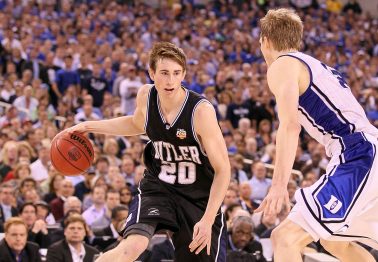To begin, a series of rhetorical questions: What is a Cinderella run? Does every March Madness tournament have to have at least one? Can a tournament have more than one? Is it only really a Cinderella run if a team wins the championship?
The reference in the metaphor (cliché?) is obviously to the (world) widely-known fairy tale, where a downtrodden young woman is transformed by magic from a neglected maid to the object of a prince's affection at a royal ball. The tale is used in sports journalism to describe a team experiencing an unexpected postseason winning streak.
Now, despite receiving per word compensation, I will not enrich the reader with the fascinating story of the Cinderella narrative's life; check out the "Explained" episode on Netflix for further details. I will only highlight those parts of the narrative that help to compose the inevitable Cinderella stories we know from each NCAA tournament.
First is Cinderella's underdog status. Cinderella-the-person went from being aggressively unnoticed and spit upon on to vibing hard with the prince at the castle and in front of literally everybody.
What is a Cinderella Story?
To be on a Cinderella run, a team must do likewise, and go from being a team playing in one of many many games on the first weekend and who's expected to lose to a team playing on the second or third weekend, this time with no other games on and everybody watching.
When you're a 15 seed like Saint Peter's, all it takes is one win to set the Cinderella wheels in motion, which they got in the first round against Kentucky. Two wins? Two wins mean all eyes are on you and, maybe more importantly, all eyes also on their third opponent, the Purdue Boilermakers. Three wins? That's something else entirely...
The second defining part of a typical NCAA Tournament Cinderella run is less inspiring and more tragic. It is the fact that nearly each and every one ends with a loss.
Cinderella-the-person's time with the prince ends at midnight, when she has to run frantically from the party before the magic wears off. It literally happens every time you read the story. Try it.
Another thing also happens to Cinderella-the-person, if you keep reading, which is that one of her fancy glass slippers comes loose from her foot during the exit and the prince picks it up and vows to find her, and thanks to the incredible fact that the shoe fit only one woman in the entire kingdom, he did.
This part of the story is rarely experienced by a team on a Cinderella run. Just ask Gonzaga.
Everyone Forgets the Happily Ever After
The "happily ever after" part of the fairy tale also does sometimes happens for a coach of a team, or a player on a team. Celtics President of Basketball Operations Brad Stevens became a household name when he, as head coach of Butler Bulldogs, went on two consecutive Cinderella runs, losing in the National Championship matchups to Mike Krzyzewski and the Duke Blue Devils in 2010 and again to Kemba Walker and the UConn Huskies in 2011.
Don't forget also that Steph Curry made his unofficial arrival into the national consciousness when he guided his 10-seed Davidson Wildcats on a run that ended in the Elite Eight with a 59-57 loss to 1-seed and eventual champion Kansas. In four games in the Midwest region, Stephen Curry averaged 32 points per.
For the first time, we saw the future. Of shooting. Of the NBA. Of basketball.
For the team, though — even Curry's — the story only always ends at the part where the clock strikes midnight and the "magic" that was behind the team's current success is suddenly gone, and things go back as they were. At midnight the team loses. Every time you watch.
With two exceptions.
The 1983 NC State Wolfpack & 1985 Villanova Wildcats Are True Cinderellas
In 1983, in a highlight you may have seen before, the 6-seed NC State Wolfpack beat the 1-seed Houston Cougars at the buzzer when Lorenzo Charles caught and dunked a Derrick Whittenburg airball.
It completed an NC State run that had started even before the NCAA Tournament, when the Wolfpack, behind coach Jim Valvano, unexpectedly won the ACC Tournament to gain an automatic bid to the Big Dance.
The Charles dunk and subsequent images of Valvano running frantically around the court with his arms open are among the most iconic and enduring images of college basketball and the NCAA Tournament.
Two years later, in 1985, 8-seed Villanova would beat 1-seed Georgetown to win the NCAA Championship. Rollie Massimino's Wildcats are still the lowest-seeded team to win it all, and Ed Pinckney & Co.'s win over Patrick Ewing and the Hoyas remains one of college basketball's all-time upsets.
It would be Ewing's final game with coach John Thompson at Georgetown, and as expected he was the first-overall pick in the NBA draft. Behind their (successful) Cinderella run, Villanova forward Ed Pinckney would go on, a little bit more unexpectedly, to be the 10th-overall pick in the same draft to the Phoenix Suns. Pinckney would play in the NBA for twelve years.
In 2014, Connecticut, with coach Kevin Ollie and behind future NBA star Kemba Walker, won the NCAA Championship as a 7-seed. Though this run was certainly unexpected, the Huskies didn't have a signature, shock-the-world win until they beat 1-seed Florida in the Final Four, and even in the Championship game, they took down another team on a surprise run in 8-seed Kentucky.
Despite UConn being the only 7-seed to win it all, this one just doesn't have the same Cinderella cred, as they were actually favored in the final game, and with the fact that even before the game started the one sure thing was that whoever won, Cinderella would be crowned.
The fact is that the championship runs of NC State and Villanova in 1983 and 1985, even UConn in 2014, are not, and should not be considered exceptions. They are the rule. They are Cinderella runs. What we witness year in and year out are teams in pursuit of a Cinderella run.
It may be the case that every tournament has at least one team that engages in a potential Cinderella run, and it may also be true that a tournament can have as many teams doing so as there are lower seeds, it must fundamentally and definitionally be so that in any given tournament, there is only room for one Cinderella.
There have been 10 Final Fours out of the past 11 that have had a 5-seed or higher, and this year's Sweet 16 boasts a 15 seed, two 11 seeds, one 10 seed and an 8 seed.
Of the questions posed, some are answered, one remains. Will we see one? How about five? But can one of them finish the story?
I'm waiting.


